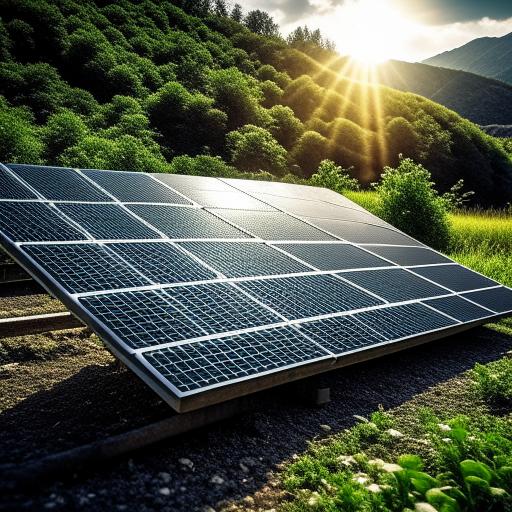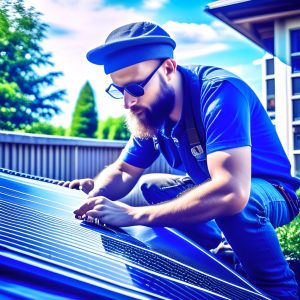A world where electricity is generated from thin air (or, more accurately, sunlight). With the advent of XCV Panels, this vision is becoming a reality. Forget everything you thought you knew about traditional solar panels – these cutting-edge wonders are here to revolutionize the renewable energy landscape. This article will take an exciting journey through the world of XCV Panels. Their groundbreaking features set them apart from other solar technologies: countless applications across residential and commercial settings, compelling benefits for individuals and the planet, and some alternatives if XCV Panels don’t quite fit your needs. Buckle up and prepare to be astonished by what’s possible when innovation meets sustainability!
What are XCV panels?
XCV panels are a revolutionary advancement in solar technology. Unlike traditional solar panels, XCV panels have a unique ability to generate higher voltages. It means they can produce more energy per panel and yield greater overall power output for any installation.
The secret behind XCV panels lies in their innovative design and the use of advanced materials. XCV panels can achieve higher conversion efficiencies by incorporating new materials that enhance electron mobility and minimize resistance losses. It translates into increased electricity generation from the same amount of sunlight, making them ideal for maximizing power production in limited space.
The Evolution of Solar Panels
To understand the significance of the XCV Panel, it is crucial to trace the evolution of solar panels over the years. Solar panels have come a long way from their inception in the mid-20th century, with materials, efficiency, and affordability advancements. This section will provide an overview of this evolution.
Development and Technology
The XCV Panel is the culmination of years of research and development, combining cutting-edge technologies and materials to maximize energy production. This section will dive into the specifics of the XCV panel’s design and technology, highlighting its innovative features and what sets it apart from traditional solar panels.
Efficiency and Performance
One of the critical attributes of the XCV Panel is its exceptional efficiency. We will explore the factors contributing to its high energy conversion rates and discuss how it outperforms conventional solar panels under various conditions.
Energy Cost Savings
Switching to XCV Panels can generate substantial energy savings for homeowners and businesses. We will discuss how the panel’s efficiency and long-term reliability contribute to these savings.
Environmental Benefits
Solar energy is renowned for its environmental benefits, and the XCV Panel is no exception. This section will elaborate on how using XCV panels can significantly reduce carbon emissions, combat climate change, and lower the ecological footprint.
Durability and Longevity
The longevity and durability of solar panels are vital considerations for consumers. We will discuss the robust construction of XCV panels and their extended lifespan, providing peace of mind to those who invest in this technology.
Benefits of XCV Panels
XCV panels are revolutionizing the solar panel industry, offering various benefits that make them stand out from traditional models. Their unparalleled efficiency ensures maximum power output per square meter, making them ideal for small spaces or roofs with limited surface area. This high efficiency is achieved through advanced technology and innovative design, allowing XCV panels to harness even low-intensity sunlight effectively.
Another critical advantage of XCV panels is their durability. Built to withstand extreme weather conditions, these panels are designed with materials that offer exceptional resistance to hail, storms, and rapid temperature fluctuations. This robustness makes them reliable in areas prone to harsh climate changes or unpredictable weather patterns.
Pros:
- High Efficiency: The XCV Solar Panel is known for its exceptional efficiency, meaning it can convert more sunlight into electricity compared to conventional solar panels. It results in higher energy production, making it a cost-effective choice.
- Energy Cost Savings: One of the primary benefits of solar panels, including the XCV, is the potential for significant energy cost savings. By harnessing solar power, you can reduce or even eliminate your electricity bills, depending on your energy consumption and location.
- Environmental Benefits: Solar energy is a clean and renewable source, and the XCV Solar Panel is no exception. By using XCV panels, you can reduce your carbon footprint and contribute to combating climate change.
- Longevity and Durability: XCV Solar Panels are designed to be durable and have a long lifespan. They are built to withstand harsh weather conditions, ensuring they continue to produce electricity for many years.
- Grid Independence: XCV Solar Panels can be integrated with energy storage solutions, allowing you to store excess energy during the day for use at night or during power outages. It can make you less reliant on the traditional electrical grid.
- Government Incentives: In many regions, there are government incentives, tax credits, and rebates for installing solar panels, making the initial investment more affordable and appealing.
- Increased Property Value: Homes and businesses with solar panels often have higher property values. Installing XCV Solar Panels can be a wise long-term investment.
- Reduced Reliance on Fossil Fuels: By using XCV Solar Panels, you reduce the demand for fossil fuels, which helps reduce air pollution and dependence on non-renewable resources.
Cons:
- High Initial Cost: The upfront cost of purchasing and installing XCV Panels can be relatively high, although government incentives and financing options can help offset this expense.
- Intermittent Energy Source: Solar energy production depends on sunlight, which means energy generation is intermittent. It can be mitigated with energy storage solutions but adds to the complexity and cost of the system.
- Space Requirement: Solar panels require a significant amount of space, which can be a limitation for homes or businesses with limited roof or ground space.
- Aesthetic Impact: Some people find solar panels unattractive and believe they can detract from the visual appeal of a building.
- Environmental Impact: The production and disposal of solar panels can have environmental impacts, primarily if not appropriately handled. However, the environmental benefits during their operational life generally outweigh these concerns.
- Dependent on Location: The effectiveness of XCV Solar Panels depends on geographic location, as the amount of sunlight varies by region. Areas with less sunlight may require a more significant investment in panels to achieve the same energy production.
- Installation and Maintenance: Installing and maintaining solar panels may require professional expertise and maintenance costs could be incurred over time.
Applications of XCV Panels in Various Industries
In the rapidly evolving world of renewable energy, XCV panels have emerged as a game-changer with unique capabilities. While primarily known for their application in the solar industry, these panels are now finding their way into various other industries, revolutionizing operations and improving efficiency.
One such industry is agriculture, where XCV panels power irrigation systems. By harnessing solar energy, farmers can reduce their reliance on traditional power sources and mitigate electricity costs significantly. Moreover, XCV panels provide a scalable solution that can be easily expanded to meet the growing demands of the agricultural sector. This technology benefits individual farmers and contributes to sustainable farming practices by reducing the environmental impact associated with fossil fuel-based irrigation methods.
Another industry benefiting from XCV panel applications is transportation. With advancements in solar technology and improved storage capacities, it is now possible to integrate XCV panels into vehicles’ infrastructure. For instance, solar-powered buses are gaining popularity in several cities worldwide, delivering zero-emission public transportation solutions while utilizing a readily available source of clean energy. Additionally, electric cars equipped with XCV panels on their rooftops can actively contribute to elongating battery life by partially recharging themselves during travel.
Installation and Maintenance of XCV Panels
Installation and maintenance of XCV panels are crucial aspects when it comes to harnessing the full potential of solar energy. These advanced solar panel systems offer numerous benefits, such as reduced electricity bills and a greener footprint. To ensure a seamless installation process, engaging professionals with expertise in handling XCV panels is essential. They possess the technical knowledge to overcome any challenges during installation, guaranteeing maximum efficiency and longevity.
Maintenance plays a pivotal role in optimizing the performance of XCV panels throughout their lifespan. Regular cleaning is imperative, as accumulated dirt or dust can hinder sunlight absorption and reduce energy output. Beyond cleaning, ensuring the proper functioning of all components is vital for optimal panel performance. Regular inspections can help identify any possible damage or malfunctioning parts early on, allowing for timely repairs or replacements at an affordable cost.
Cost Considerations of XCV Panels
When considering the costs of XCV panels, it’s crucial to look beyond just the initial investment. While these cutting-edge solar panels may have a higher upfront price than their traditional counterparts, they boast several advantages that make them worth every penny.
FAQ With Answers
Here is some question answers to understand the Topic.
1. What are XCV Panels?
XCV Panels are a type of photovoltaic panel designed to capture sunlight and convert it into electricity. They are known for their high efficiency and advanced technology, making them a popular choice for those looking to harness solar energy.
2. How do XCV Panels work?
XCV Panels work by using photovoltaic cells to convert sunlight into electricity. These cells are made of semiconductor materials that generate an electric current when exposed to sunlight. The electricity produced can then be used to power your home business or be fed back into the grid.
3. What makes XCV Panels different from standard solar panels?
XCV Panels are known for their exceptional efficiency, which means they can convert a higher percentage of sunlight into electricity compared to traditional solar panels. They also often incorporate advanced materials and technologies to enhance their performance.
4. What are the advantages of using XCV Panels?
The advantages of using XCV Solar Panels include:
- Higher energy production.
- Energy cost savings.
- Environmental benefits.
- Long-term durability.
- Grid independence.
- It increased property value.
- Access to government incentives and rebates.
5. Are XCV Panels suitable for my location?
The effectiveness of XCV Panels depends on your geographic location. Areas with more sunlight generally benefit from solar panels. Still, they can also be used in regions with less sunlight, albeit with an enormous investment in panels to achieve the same energy production.
6. How long do XCV Panels last?
XCV Solar Panels are designed to be durable and have a long lifespan, typically ranging from 25 to 30 years or more. Regular maintenance can help extend their life.
7. Do XCV Panels require a lot of maintenance?
Solar panels, including XCV Solar Panels, require minimal maintenance. Cleaning the panels periodically and ensuring they are debris-free is usually sufficient. Having a professional check the system periodically is also a good idea.
8. Can XCV Panels work during power outages?
XCV Panels can provide electricity during a power outage if integrated with an energy storage solution, such as batteries. It allows you to use the stored energy when the sun is not shining or the grid is down.
9. How do I finance the installation of XCV Solar Panels?
Various financing options are available for installing XCV Solar Panels, including purchasing them outright, leasing, or entering into a Power Purchase Agreement (PPA). Additionally, many regions offer government incentives, tax credits, and rebates to help offset the initial cost.
10. Are XCV Solar Panels eco-friendly?
Yes, XCV Solar Panels are environmentally friendly as they harness solar energy, a clean and renewable resource. Using them reduces your carbon footprint and helps combat climate change.
11. Can I install XCV Solar Panels independently or do I need a professional installer?
While some DIY solar panel kits are available, it’s generally recommended to have XCV Solar Panels installed by a professional. Proper installation ensures safety and maximizes performance.
12. Can I return excess energy to the grid with XCV Solar Panels?
Yes, you can sell excess energy generated by your XCV Solar Panels back to the grid in many regions, a practice known as “net metering.” It can further reduce your energy costs and benefit the grid.
13. What is the warranty for XCV Solar Panels?
The warranty for XCV Solar Panels typically covers at least 20-25 years. It’s essential to understand the specifics of the warranty provided by the manufacturer and installer.
14. Can I use XCV Solar Panels in a cloudy or rainy climate?
While XCV Solar Panels are more efficient in sunny climates, they can still generate electricity in cloudy or rainy conditions. Their efficiency may be lower, but they can be a viable energy source.
Final Thoughts
The XCV Panel is undeniably a revolutionary development in the field of solar energy. This article has provided a comprehensive exploration of its features, advantages, applications, and impact on the path toward a more sustainable and renewable energy future. As solar technology advances, the XCV Solar Panel is a testament to human innovation and the limitless potential of harnessing the sun’s power.


